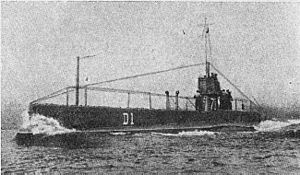
The Amphion class of British diesel-electric submarines were designed for use in the Pacific War. Only two were completed before the end of hostilities, but following modernisation in the 1950s, they continued to serve in the Royal Navy into the 1970s.

The Flower-class corvette was a British class of 294 corvettes used during World War II by the Allied navies particularly as anti-submarine convoy escorts in the Battle of the Atlantic. Royal Navy ships of this class were named after flowers.

The British C-class submarines were the last class of petrol engined submarines of the Royal Navy and marked the end of the development of the Holland class in the Royal Navy. Thirty-eight were constructed between 1905 and 1910 and they served through World War I.
The R-class submarines were a class of 12 small British diesel-electric submarines built for the Royal Navy during World War I, and were forerunners of the modern attack submarine, in that they were designed specifically to attack and sink enemy submarines, their battery capacity and hull shape being optimized for underwater performance.

HMS D1 was one of eight D-class submarine built for the Royal Navy during the first decade of the 20th century.

HMS D2 was one of eight D-class submarine built for the Royal Navy during the first decade of the 20th century.
HMS D3 was a D-class submarine of the British Royal Navy, one of eight of this class. D3 was built by Vickers at their Barrow-in-Furness works in 1910–1911, being launched on 17 October 1910 and completed on 30 August 1911.

HMS D4 was a British D-class submarine built by Vickers, Barrow. D4 was laid down on 24 February 1910, launched 27 May 1911 and was commissioned on 29 November 1911. She was the first submarine to be fitted with a gun for offensive use.
HMS D5 was one of eight D-class submarines built for the Royal Navy during the first decade of the 20th century.
HMS D6 was one of eight D-class submarine built for the Royal Navy during the first decade of the 20th century.
HMS D7 was one of eight D-class submarines built for the Royal Navy during the first decade of the 20th century.
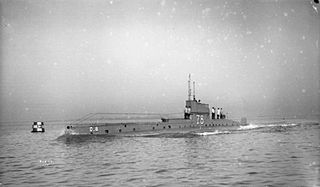
HMS D8 was one of eight D-class submarines built for the Royal Navy during the first decade of the 20th century.

HMS E5 was a British E-class submarine built by Vickers Barrow-in-Furness. She was laid down on 9 June 1911 and was commissioned on 28 June 1913. She cost £106,700. E5 was sunk, probably by striking a mine, on 7 March 1916.

HMS E7 was a British E class submarine built at Chatham Dockyard. She was laid down on 30 March 1912 and was commissioned on 16 March 1914. She cost £105,700.
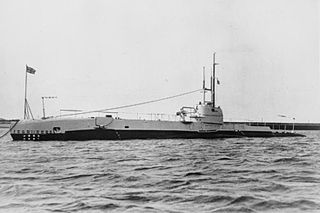
HMS Snapper was a second-batch S-class submarine built during the 1930s for the Royal Navy. Completed in 1935, the boat participated in the Second World War. Snapper is one of the 12 boats named in the song "Twelve Little S-Boats".
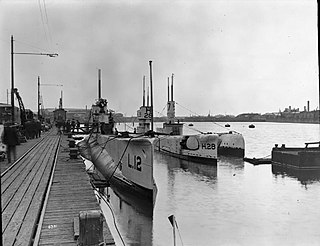
HMS L12 was a L-class submarine built for the Royal Navy during World War I. She was one of five boats in the class to be fitted as a minelayer. The boat survived the war and was sold for scrap in 1932.

Orgel diagrams are correlation diagrams which show the relative energies of electronic terms in transition metal complexes, much like Tanabe–Sugano diagrams. They are named after their creator, Leslie Orgel. Orgel diagrams are restricted to only show weak field cases, and offer no information about strong field cases. Because Orgel diagrams are qualitative, no energy calculations can be performed from these diagrams; also, Orgel diagrams only show the symmetry states of the highest spin multiplicity instead of all possible terms, unlike a Tanabe–Sugano diagram. Orgel diagrams will, however, show the number of spin allowed transitions, along with their respective symmetry designations. In an Orgel diagram, the parent term in the presence of no ligand field is located in the center of the diagram, with the terms due to that electronic configuration in a ligand field at each side. There are two Orgel diagrams, one for d1, d4, d6, and d9 configurations and the other with d2, d3, d7, and d8 configurations.
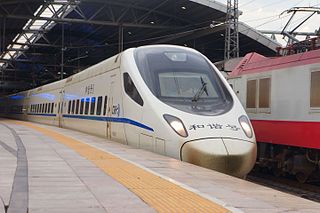
The Beijing-Shenyang Through Train is a Chinese railway that runs between the capital of China, Beijing to Shenyang, the capital of Liaoning. An express passenger train jointly operated by the Beijing Railway Bureau and Shenyang Railway Bureau, the Shenyang Railway Bureau is responsible for passenger transportation. CRH5 Type Passenger trains run along the Jingha Railway across Liaoning, Hebei, Tianjin, Beijing, and other provinces and cities for 622 km.
The Nabadwip Dham–Malda Town Express is an Express train belonging to Eastern Railway zone that runs between Malda Town and Nabadwip Dham railway station in Indian state of West Bengal. It is currently being operated with 13421/13422 train numbers on a daily basis.
